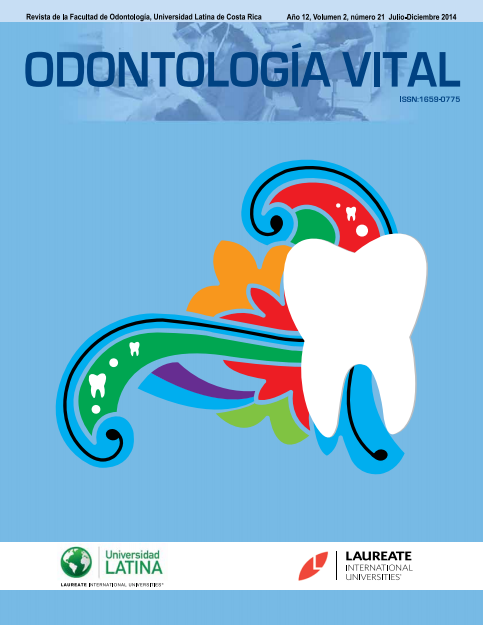Articaine: Local Anesthetic. Bibliographic review
DOI:
https://doi.org/10.59334/ROV.v2i21.292Keywords:
Articaine, chemical properties, metabolism, excretionAbstract
Local anesthetics are widely used in daily clinical practice in different dental procedures, so it is essential to know the most relevant pharmacological aspects of local anesthetics in order to optimize them, improve patient experience, and minimize complications related to their use.
Articaine is an amide anesthetic of intermediate duration, short acting, and fast metabolism due to an ester group in its structure. In addition, it is effective with local infiltration or nerve block procedures in dentistry. For the latter and due to Articaine’s great popularity in the dental field, the following literature review is presented.
Downloads
References
Andersson, L. Kahnberg, KE, Pogrel, MA. (2010). Oral and maxillofacial sur-gery. Editorial Wiley-Blackwell. Primera edición. Blackwell Publishing Ltd. pp 51, 57, 58,59
Cummings, D., Yamashita, D., McAndrews, J. (2011). Complications of local anesthesia used in oral and maxillofacial surgery. Oral Maxilofacial Surg Clin N Am 23 (2011) 369-377 doi:10.1016/j.coms.2011.04.009. Elsevier In All rights reservd. https://doi.org/10.1016/j.coms.2011.04.009
Daublander M, Muller R, Lipp MD. (1997). The incidence of complications associated with local anesthesia in dentistry. Anesth Prog 1997;44:132-141. Ensaldo E, Ensaldo ED, Rivas R, Adler S. (2003). Estudio clínico comparati-vo entre articaína y lidocaína. Rev ADM 2003;60(3): 212-218
Gaffen A S, Haas D A. (2009). Retrospective review of voluntary reports of nonsurgical paresthesia in dentistry. J Can Dent Assoc 2009; 75: 579.
García, A. Guisado, B. Montalvo, J. (2003). Riesgos y complicaciones de la anestesia local en la consulta dental. Estado actual. RCOE 2003;8(1):41-63. https://doi.org/10.4321/S1138-123X2003000100004
Garisto G A, Gaffen A S, Lawrence H P, Tenenbaum H C, Haas D A.( 2010). Occurrence of paresthesia after dental local anesthetic administration in the United States. J Am Dent Assoc 2010; 141: 836–844. https://doi.org/10.14219/jada.archive.2010.0281
Haas DA, Lennon D. (1995). Local anesthetic use by dentists in Ontario. J Can Dent Assoc 1995;61:297-304.
Isen DA. (2000). Articaine: pharmacology and clinical use of a recently ap-proved local anesthetic. Dent Today 2000;19:72-77
Jakobs W.(1989). Status of dental anesthesia in Germany. Anesth Prog 1989;36:210-212.
Johansen, O. (2004). Comparison of articaine and lidocaine used as dental local anesthetics. Tesis, Universidad de Oslo. Mayo 2004
Malamed S. F. ( 2006). Manual de anestesia local. 5th ed. Madrid, España 2006. pp 15, 71, 72, 73, 145, 146, 147
Malamed SF, Gagnon S, Leblanc D. (2000). A comparison between articaine HCl and lidocaine HCl in pediatric dental patients. Pediatr Dent;22:307-11
Malamed SF, Gagnon S, Leblanc D. (2000). Efficacy of articaine: a new ami-de local anesthetic. J Am Dent Assoc 2000;131:635-42. https://doi.org/10.14219/jada.archive.2000.0237
Oertel R, Ebert U, Rahn R, Kirch W. (1997). Clinical pharmacokinetics of articaine. Clin Pharmacokinet. 1997 Dec;33(6):418. https://doi.org/10.2165/00003088-199733060-00002
Reyes, R.D., Aldana, J.L. (2010). Anestésicos locales: de los conceptos básicos a la práctica clínica. Rev Col Or Tra 2010;24(1):32-9
Schertzer ER,Jr. (2000). Articaine vs. lidocaine. J Am Dent Assoc 2000;131:1242-1243. https://doi.org/10.14219/jada.archive.2000.0367
Sierra, A. Delgado, E. Berini, L. Gay, C. (2007). Comparative study of the anesthetic efficacy of 4% articaine versus 2% lidocaine in inferior alveolar nerve block during surgical extraction of impacted lower third molars. Med Oral Patol Oral Cir Bucal 2007;12: E139-44.
Snoeck, M. (2012). Articaine: a review of its use for local and regional anesthesia. Local and Regional Anesthesia 2012:5 23–33. https://doi.org/10.2147/LRA.S16682
Subramaniam S, Tennant M. (2005). A concise review of the basic biology and pharmacology of local analgesia. Aust Dent J 2005; 50(4 Suppl 2): S23–30. https://doi.org/10.1111/j.1834-7819.2005.tb00380.x
Trejo, S. (1992). Farmacología y terapéutica sstomatológica en clínica privada. Editorial Méndez Editores. México DF. 1992:130-144
Valerio, Y. Perez, S (2007). Comparativo entre articaína y lidocaína. Revista Mexicana de Odontología. Año 2, No 1 2007;26-32
Vahatalo, K. Antila, H. Lehtinen, R. (1993). Articaine and lidocaine for maxillary infiltration anesthesia. Anesth Prog 40:114-116 1993.
Vree T, Gielen M. (2005). Clinical pharmacology and the use of articaine for local and regional anaesthesia. Best Pract Res Clin Anaesthesiol. 2005 Jun;19(2):293-308. https://doi.org/10.1016/j.bpa.2004.12.006
Vree T, Simon M, Gielen M. Booij L. (1997). Regional metabolism of articaine in 10 patients undergoing intrave-nous regional anaesthesia during day case surgery. Br J Clin Pharmacol. 1997;44:29–34.
Weaver JM. (1999). Articaine, a new local anesthetic for American dentists: will it supersede lidocaine? Anesth Prog 1999;46:111-112.
Yapp, KE. Hopcraft, MS. Parashos, P. (2011). Articaine: a review of the literature. British Dental Journal Volume 210 No 7, Abril 9 2011; 323–329. https://doi.org/10.1038/sj.bdj.2011.240
Downloads
Published
How to Cite
Issue
Section
License
Copyright (c) 2014 Odontología Vital

This work is licensed under a Creative Commons Attribution 4.0 International License.
Authors who publish with Odontología Vital agree to the following terms:
- Authors retain the copyright and grant Universidad Latina de Costa Rica the right of first publication, with the work simultaneously licensed under a Creative Commons Attribution 4.0 International license (CC BY 4.0) that allows others to share the work with an acknowledgement of the work's authorship and initial publication in this journal.
- Authors are able to enter into separate, additional contractual arrangements for the non-exclusive distribution of the Odontología Vital's published version of the work (e.g., post it to an institutional repository or publish it in a book), with an acknowledgement of its initial publication.
- Authors are permitted and encouraged to post their work online (e.g., in institutional repositories or on their website) prior to and during the submission process, as it can lead to productive exchanges, as well as earlier and greater citation of published work.
Métricas alternativas











